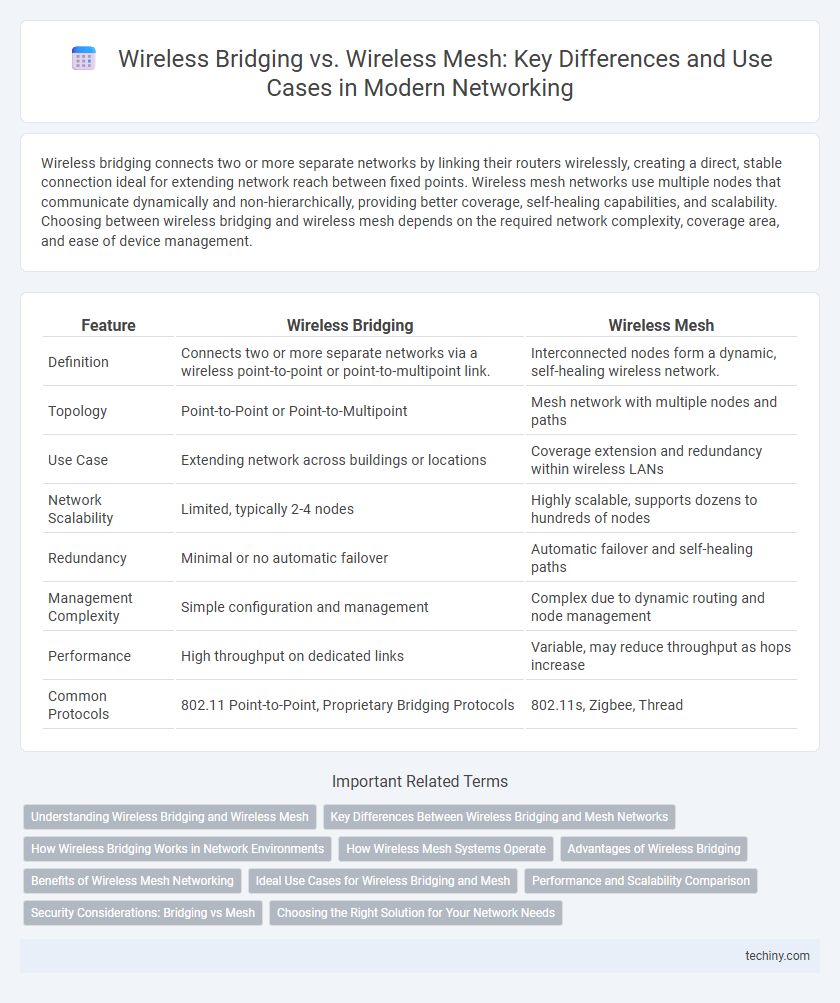Wireless bridging connects two or more separate networks by linking their routers wirelessly, creating a direct, stable connection ideal for extending network reach between fixed points. Wireless mesh networks use multiple nodes that communicate dynamically and non-hierarchically, providing better coverage, self-healing capabilities, and scalability. Choosing between wireless bridging and wireless mesh depends on the required network complexity, coverage area, and ease of device management.
Table of Comparison
| Feature | Wireless Bridging | Wireless Mesh |
|---|---|---|
| Definition | Connects two or more separate networks via a wireless point-to-point or point-to-multipoint link. | Interconnected nodes form a dynamic, self-healing wireless network. |
| Topology | Point-to-Point or Point-to-Multipoint | Mesh network with multiple nodes and paths |
| Use Case | Extending network across buildings or locations | Coverage extension and redundancy within wireless LANs |
| Network Scalability | Limited, typically 2-4 nodes | Highly scalable, supports dozens to hundreds of nodes |
| Redundancy | Minimal or no automatic failover | Automatic failover and self-healing paths |
| Management Complexity | Simple configuration and management | Complex due to dynamic routing and node management |
| Performance | High throughput on dedicated links | Variable, may reduce throughput as hops increase |
| Common Protocols | 802.11 Point-to-Point, Proprietary Bridging Protocols | 802.11s, Zigbee, Thread |
Understanding Wireless Bridging and Wireless Mesh
Wireless bridging connects two or more separate networks by linking their access points wirelessly, often used to extend network coverage without physical cables. Wireless mesh networks consist of multiple nodes that dynamically route data among themselves, enhancing network resilience and coverage through self-healing and self-configuring capabilities. Understanding the distinction helps in selecting the appropriate wireless solution for specific environments such as point-to-point connectivity versus scalable, multi-node networks.
Key Differences Between Wireless Bridging and Mesh Networks
Wireless bridging connects two or more separate networks by creating a dedicated point-to-point or point-to-multipoint link, extending network coverage without requiring additional IP subnet configurations. Wireless mesh networks consist of multiple interconnected nodes that dynamically route traffic, providing self-healing and scalable network topologies ideal for wide-area coverage. Key differences include network architecture, scalability, and redundancy, with bridging suited for linking distinct network segments and mesh optimized for robust, flexible connectivity within a single logical network.
How Wireless Bridging Works in Network Environments
Wireless bridging connects two or more separate network segments by creating a point-to-point or point-to-multipoint link using wireless access points, effectively extending the LAN over a wireless connection. It operates by forwarding Ethernet frames between bridged devices using MAC address forwarding, maintaining network transparency and seamless integration. This method is ideal for linking distant buildings or isolated network areas where cabling is impractical, preserving bandwidth and reducing latency compared to wireless mesh network topologies.
How Wireless Mesh Systems Operate
Wireless mesh systems operate by connecting multiple nodes wirelessly, creating a decentralized network where each node communicates with others to extend coverage and improve reliability. These nodes dynamically route data through the most efficient paths, ensuring seamless connectivity even if one node fails or encounters interference. This self-healing and self-configuring capability distinguishes wireless mesh from traditional wireless bridging.
Advantages of Wireless Bridging
Wireless bridging offers superior point-to-point connectivity with high-speed data transfer and reduced latency, making it ideal for linking two distant networks securely. This method provides a dedicated communication path that minimizes interference and maximizes bandwidth efficiency compared to wireless mesh networks. Wireless bridging also simplifies network management by creating a direct link without the complexity of multiple nodes or dynamic routing protocols.
Benefits of Wireless Mesh Networking
Wireless mesh networking enhances network reliability by creating multiple redundant communication paths, ensuring continuous connectivity even if one node fails. It provides scalable coverage, easily expanding to accommodate more devices without significant infrastructure changes. Mesh networks optimize bandwidth by dynamically routing data through the most efficient paths, reducing latency and improving overall network performance.
Ideal Use Cases for Wireless Bridging and Mesh
Wireless bridging is ideal for extending network connectivity between two distant buildings or locations where a direct line-of-sight connection is possible, providing a dedicated and high-throughput link. Wireless mesh networks excel in complex environments requiring scalable, flexible coverage with multiple nodes that dynamically route data to maintain network resilience and self-healing capabilities. Enterprises deploying campus-wide Wi-Fi, smart city infrastructure, or large industrial sites benefit from mesh networks, while point-to-point connections for branch offices or remote sites favor wireless bridging solutions.
Performance and Scalability Comparison
Wireless bridging delivers high performance with dedicated point-to-point or point-to-multipoint links, ensuring low latency and stable connections ideal for connecting fixed locations. Wireless mesh networks provide greater scalability by dynamically routing data through multiple nodes, enhancing network redundancy and coverage but potentially introducing higher latency due to multi-hop transmissions. For large-scale deployments, mesh networks offer flexible expansion, while bridging excels in environments demanding consistent throughput and minimal interference.
Security Considerations: Bridging vs Mesh
Wireless bridging offers direct point-to-point connections that simplify security management through encrypted links and limited access points, reducing vulnerability exposure. Wireless mesh networks, while providing robust redundancy and self-healing capabilities, require comprehensive encryption protocols and stringent authentication across multiple nodes to prevent unauthorized access. Both architectures demand rigorous monitoring, but mesh networks introduce increased attack surfaces due to their decentralized nature and dynamic topology.
Choosing the Right Solution for Your Network Needs
Wireless bridging creates a direct, point-to-point connection between two networks, ideal for extending connectivity across buildings with minimal interference. Wireless mesh networks provide dynamic, self-healing coverage by linking multiple nodes, perfect for large or complex environments requiring robust redundancy. Assess network size, coverage requirements, and potential interference to determine whether the simplicity of bridging or the flexibility of mesh best fits your infrastructure needs.
Wireless Bridging vs Wireless Mesh Infographic

 techiny.com
techiny.com